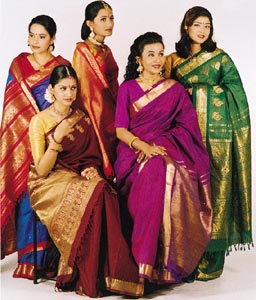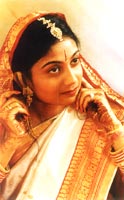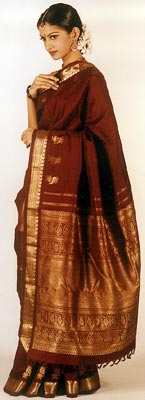|
The
saree story
 Six yards of clothes. That is all
there is to the sarees. Yet, it lends a certain grace and elegance to the
wearer unmatched by any other garment. More importantly, the saree epitomizes
the continuity of an age-old tradition that has withstood the onslaught of many
different cultures, to emerge today as a visible symbol of the resiliency,
continuity and timelessness of the Indian way of life. Six yards of clothes. That is all
there is to the sarees. Yet, it lends a certain grace and elegance to the
wearer unmatched by any other garment. More importantly, the saree epitomizes
the continuity of an age-old tradition that has withstood the onslaught of many
different cultures, to emerge today as a visible symbol of the resiliency,
continuity and timelessness of the Indian way of life.
So interwoven is the saree with the life and traditions of
the people that each region of the country has developed a weave of its own.
Each is a unique expression of the skills of the weavers and dyers, which have
been handed down the generations. The exquisite Patola weave, and the Bandhini
style of dyeing comes from the west. Weaving silks in vibrant colors, some
weighing as much as 10 kilograms is a specialty of south India. Silk sarees
embroidered with the Kantha stitch, a specialty of the Bengal region in the
east, is a typical example of the perseverance of the Indian craftsman. He puts
in as much as six months of labor to create a single saree. The Paithani silk
saree from Maharashtra and the brocades from Benaras are equally representative
of the continuation of the age-old crafts.
Then again, each region displays
a different style of draping the saree. This is usually determined by the
lifestyle of the people of that region. The urban Indian style is by far the
one most common seen. Stiff tangails, flowing silks, elegant chiffons and
heavy
brocades - all of them can be easily maneuvered into this style. Tied around
the waist, the saree forms a skirt with the pleats positioned in front thus
allowing for free movement. The Pallav or the part draped over the left
shoulder is either pleated and pinned up the convenience, or is left flowing loose
for glamour.
Tucked away in the mountains, in
the south is Coorg, undoubtedly one of the most beautiful places in India.
The women here wear the saree in
a style so unique, that its very elegance is intriguing. The pleats of the
saree are not in front but at the back forming a fan. The pallav covering the
chest is brought over the right shoulder. This is held in place with a broach
or a pin. And as they walk, the pleats behind gently swing giving the
impression of the long train, lending grace and elegance to the already
exceedingly beautiful women of this land.
The Bengalis of eastern India are
tradition bound. Bengali women are exceedingly active, yet fiercely
traditional. This is perhaps best reflected in the fact that at festival time,
come what may, all Bengali women make it a point to drape their saree in the
Bengali way. Here there are no pleats. The saree is wrapped around the waist
and tucked in at the left. This is then brought back to the right side and
draped over the left shoulder. The portion left over is brought up under the
right arm and draped once again over.
In the south is the style of
Tamil Nadu, a repository of India's ancient fine arts, dance and music.
Protected by the hills, this region enjoyed long years of peace which not only
nurtured the arts, but also developed a religious fervor that can still be seen
among its people. The followers of the Hindu religion were divided into two
distinct groups. Those who worshipped Lord Shiva came to be known as lyers and
the worshippers of Lord Vishnu were as lyengars. So distinct were these two
groups that they differed even in the way the women draped the tradition saree.
In both communities it was the
nine yard saree that was worn. The draping of the saree in this style is rather
complicated and perhaps needs to be explained step by step. After the first
wrapping around the waist, the saree is brought back and pleated with the
pleats positioned along the left leg. The rest of the saree is draped over the
left shoulder, wrapped once again round the waist and tucked on the left side.
However the lyer style includes a few pleats at the back which is not there in the lyengar
style. It is not very often that one sees women dressed in such sarees today.
The style is by far, too cumbersome for the modern women. But at weddings this
is a must, and so it is perhaps only once in a life time that the Brahmin women
of Tamil Nadu wear the saree in this style. What is more, the enterprising
clothiers have now introduced ready-to-wear nine-yard sarees, all complete with
hooks and buttons, offering a welcome alternative to trendy young girls!
-----------------------------------------------------------------------------------------------------------------------------------------------
Tips for Brides Archive

"Swish -Swashing"
|
|